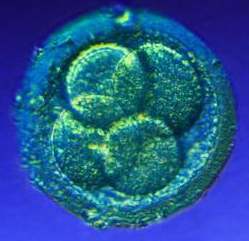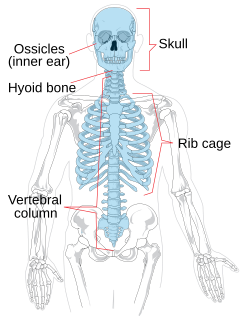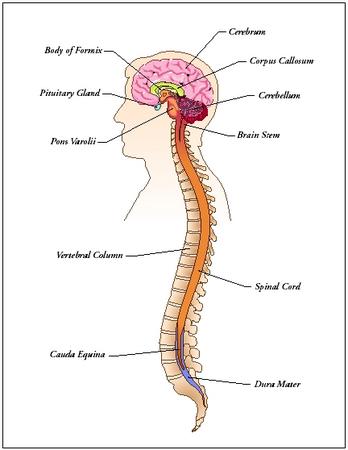






























I. The nervous system
A. Overview
1. nerve tissue
2. neuron structure
3. myelin sheath
4. nerve impulse
5. action potential
6. synapse
B. Central Nervous System
1. spinal cord
2. brain
C Limbic System and higher mental functions
D. Peripheral Nervous System
1. somatic system
2. autonomic system
E. Drug Abuse
II. Senses
A. Sensory Receptors and Sensations
1. types of receptors
2. how sensation happens
B. proprioceptors and cutaneous receptors
C. Senses of Taste and Smell
D. Sense of Vision
E. Sense of Hearing
F. Sense of Equilibrium
The nervous system is divided into two major sections : the central nervous system, or CNS, and the peripheral nervous system, or PNS. The CNS consists of the brain and spinal cord, and the PNS consists of nerves. There are three specific functions of the nervous system :receive sensory input, perform integration, and generates motor output.

There are two types of cells found in nervous tissue. Neurons transmit nerve impulses in the nervous system, and neuroglia support and nourish the neurons. There are three specific types of neurons : a sensory neuron takes nerve impulses to the CNS, motor neurons take nerve impulses away from the CNS, and effectors carry out our responses to environmental changes. All neurons have three parts, a cell body, dendrites, and an axon.
A protective layer called a myelin sheath covers many axons. In the PNS this covering is formed by Schwann cells. The gaps in an axon where there is no myelin sheath are called nodes of Ranvier. Long axons are more likely to have a myelin sheath. The myelin sheath helps with nerve regeneration in the PNS.

Nerve impulses pass along information in the nervous system. A voltmeter measures voltage and helps us to study the nerve impulse. When the axon is not conducting any impulses, the voltmeter registers membrane potential of about 65mV.
An action potential is a rapid change in polarity across an axonal membrane during a nerve impulse. It requires two types of gated channel proteins : sodium and potassium.
When there is no myelination on an axon, the action potential at one location causes an adjacent part to produce an action potential. When an impulse has passed by each portion of an axon, a refractory period occurs and the sodium gates will not open, ensuring that the action potential does not move backwards.
All axons branch into many fine endings tipped by an axon terminal which is very close to the dendrite or cell body of another neuron. This area of close proximity is known as a synapse. Transmission across a synapse is carried out by neurotransmitters. There are more than 100 substances known to be neurotransmitters. A single neuron is on the receiving end of many signals. They integrate these signals, summing up excitatory and inhibitory signals. Excitatory signals cause an axon to transmit a nerve impulse, an inhibitory prohibits the axon from doing so.
The CNS is made up of the spinal cord and the brain. Both of these are protected by bone. They are also wrapped in protective membranes known as meninges. The CNS is composed of gray matter which contains cell bodies and nonmyelinated fibers, and white matter which contains myelinated axons that run together in tracts.

The spinal cord begins at the base of the brain and extends into the vertebral canal. The spinal nerves project from the cord i between the vertebrae. The central canal contains cerebrospinal fluid. The spinal cord is the means of communication between the brain and peripheral nerves. The center for thousands of reflex arcs is in the spinal cord.
The cerebrum is the largest portion of the brain. It is the last center that receives sensory input and carries out integration. It coordinates activities of all other parts of the brain. The cerebrum has two halves, called cerebral hemispheres. Each hemisphere is divided into lobes - the frontal lobe, parietal lobe, occipital lobe, and temporal lobe. Each lobe is associated with different functions. The cerebral cortex is a layer of gray matter that covers the cerebral hemispheres. The primary motor area is located in the frontal lobe. The primary somatosensory area is in the parietal lobe. This is where sensory information from the skin and skeletal muscles arrives. Integration occurs in places called association areas. Processing centers receive information from other association areas. The prefrontal area uses this information to reason and plan actions. The ability to speak is dependent on two areas called Wernicke’s area and Broca’s area.

The cerebellum is under the occipital lobe of the cerebrum. It receives sensory input from the eyes, ears, joints, and muscles. The brainstem contains the midbrain and the medulla oblongata which regulates heartbeat, breathing, and blood pressure. The reticular formation is a main component of the reticular activating system which arouses the cerebrum and causes a person to become alert.
The limbic system is what controls our emotions and higher mental functions. This system is located deep in the cerebrum. The amygdala can cause experiences to have emotions associated with them and creates fear. The hippocampus is important to learning and memory.
Memory is defined as the ability to hold a thought in mind. Learning is the ability to retain and utilize past memories. There are several different types of memory :
short term, long term, semantic (letters. numbers, words) and episodic(persons and events).
There is another type of memory called skill memory which is involved in performing motor activities as we learn them. Language comes from semantic memory.
The left and right hemispheres of the brain serve different functions. The left half is associated with verbal, logical, and rational thoughts. The right is associated with nonverbal, intuitive, and creative thoughts.
The peripheral nervous system, or PNS, is where our nerves are. Humans have a dozen pairs of cranial nerves that are attached to the brain. There are 31 pairs of spinal nerves which emerge from the spinal cord. A dorsal root ganglion is the cell body of a sensory neuron.
The somatic system is part of the PNS. It serves the skin, skeletal muscles, and tendons. These nerves take sensory information from external receptors to the CNS and motor commands to the skeletal muscles.
The autonomic system is another part of the PNS. Its function is to regulate the activity of cardiac and smooth muscles and glands. It is divided into two areas. The sympathetic division kicks in in emergency situations, accelerating the heartbeat and dilating the bronchi. The parasympathetic division promotes all of the internal responses coming from a relaxed state.
Drugs can affect the nervous system and alter the mood or emotional state. Drug abusers take drugs that affect the reward circuit to where they neglect their basic needs and continue drug use. Drug abuse becomes obvious when a person is taking a drug at a dose level and under circumstances that can increase the risk of a harmful effect.

Alcohol is the most accepted form of drug use. It can have harmful effects on the brain and the body. It very easily crosses the blood brain barrier and causes damage to several tissues, including the liver and the brain.
Nicotine is another common form of drug use. It binds to neurons in the CNS, releasing dopamine.
While alcohol and nicotine are legal, there are other illegal drugs that are used and cause severe problems in the nervous system. Some of the more well known ones are cocaine, methamphetamine, heroin, and marijuana.
There are four categories of sensory receptors in humans. The first type is a chemoreceptor. These respond to chemical substances in the immediate area. Pain receptors are a type of chemoreceptors and are naked dendrites that alert us to possible danger. Photoreceptors respond to light energy and provide us with the sense of vision. Mechanoreceptors are stimulated by mechanical forces and result in pressure, giving us the sense of touch. Thermoreceptors are stimulated by changes in temperature.
Sensory receptors generate nerve impulses. When these impulses arrive at the brain, sensation occurs.
Proprioceptors, cutaneous receptors, and pain receptors send nerve impulses to the spinal cord where they travel to the somatosensory areas of the cerebral cortex. Proprioceptors are involved in reflex actions maintaining the body’s equilibrium and posture. They help us to be aware of the position of our limbs in space. Cutaneous receptors are located in the dermis of the skin and make the skin receptive to touch, pressure, pain, and temperature.

The senses of taste and smell are called chemical senses. Taste cells and olfactory cells contain chemoreceptors. Adult humans have about 3,000 taste buds on their tongue. There are four primary types of taste - sweet, sour, salty, and bitter. Taste buds have an opening called a taste pore. Molecules bind to the receptor proteins and generate nerve impulses that go to the brain. When the reach the gustatory, or taste, cortex, they are interpreted as tastes.
About 80-90% of what we taste is related to smell. Our sense of smell comes from 10-20 million olfactory cells located high in the roof of the nasal cavity. Each olfactory cell has only one type of receptor proteins. Different odors stimulate different olfactory cells.

Our senses of vision requires the eyes and the brain. The eyeball has three layers - the sclera, the choroid, and the retina. The lens is located in the choroid layer, and its function is to focus images on the retina. The lens and the humors assist in this. Rays of light pass through the lens and light rays are refracted when brought into focus. The photoreceptor have two structures - rod cells and cone cells. The retina has three layers of neurons. The rod cells and cone cells synapse with the bipolar cells which synapse with ganglion cells and the axons become the optic nerve. There are no rods and cones where the optic nerve exits the retina. This produces a blind spot in each eye. In order to reach the visual cortex, optic nerves carry impulses to the optic chiasma. This is where depth perception comes from. Some people have distance problems with their eyes. Nearsighted people have an elongated eyeball causing them to see close objects better than those at a distance. Farsighted people have shortened eyeballs which cause the opposite vision. Color blindness is another common abnormality of the eye.
The ear is where we get our sense of hearing. The ear consists of the outer, middle, and inner sections. The outer ear consists of the pinna and the auditory canal. The middle ear begins at the tympanic membrane (eardrum), and ends at a bony wall containing the oval window and the round window. The inner ear is filled with fluid. Hearing begins when sound waves enter the auditory canal. These sound waves vibrate molecules. The stapes strikes the oval window's outer membrane, causing it to vibrate, which passes pressure to the fluid in the cochlea. The sense organ for hearing is called the spinal organ which is located in the cochlear canal. Each part of this organ is sensitive to different wave frequencies.

The sense of equilibrium also comes from our ears. Mechanoreceptors in the semicircular canals detect rotational and angular movement of the head, known as rotational equilibrium. The base of the canals are called the ampulla. The brain uses information from the hair cells in the ampulla to maintain equilibrium through motor output to skeletal muscles that can right our position in space. The mechanoreceptors in the utricle and saccule detect movement of the head in the vertical or horizontal, known as gravitational equilibrium.
Images were from these sites
http://academic.wsc.edu/faculty/jatodd1/ap1/muscle.jpg, http://cwx.prenhall.com/bookbind/pubbooks/morris5/medialib/images/F02_01.jp
ghttp://www.faqs.org/health/images/uchr_02_img0126.jpg
http://www.dwp.gov.uk/medical/med_conditions/images/brain.gif

